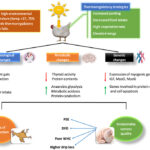
1. Introduction
Low-quality roughages such as crop residues (e.g., wheat straw, rice straw, maize stover, and sugarcane tops) and mature grasses are widely available and form the bulk of livestock feed in many developing countries. However, they have:
- Low crude protein (2–6%)
- High fiber content
- Poor digestibility (40–50%)
- Low palatability
As a result, animals consuming only these feeds often show poor growth, low milk production, and reduced reproductive performance. Improving the nutritional quality of these roughages is essential to enhance livestock productivity, especially in resource-poor settings.
2. Key Strategies to Improve Nutritional Quality
A. Physical Treatments
1. Chopping and Grinding
- Purpose: Reduces particle size, increases surface area for microbial action in the rumen, and improves intake.
- Tools used: Chaff cutters, hammer mills.
- Benefits: Better mixing with concentrates or supplements, reduced sorting by animals.
2. Soaking
- Method: Soaking straw in water (plain or saline water) for several hours.
- Effect: Helps in softening the material, leaching out anti-nutritional compounds, and improving palatability.
B. Chemical Treatments
1. Urea-Ammonia Treatment
- Most widely used technique for enhancing poor-quality roughages.
- Method:
- Add 4% urea solution to straw (4 kg urea in 100 liters water per 100 kg straw).
- Stack it in an airtight condition (using plastic sheets) for 7–21 days.
- Reaction: Urea breaks down into ammonia, which disrupts lignin-cellulose bonds.
- Benefits:
- Increases crude protein from ~3% to 8–10%.
- Improves digestibility and voluntary intake.
2. Alkaline Treatment (Sodium Hydroxide, Lime)
- Sodium hydroxide (NaOH): Breaks lignocellulosic bonds, improving digestibility.
- Lime (Ca(OH)₂): Safer and cheaper alternative to NaOH.
- Challenges: Cost and handling safety.
C. Biological Treatments
1. Fungal Treatment
- Use of white-rot fungi (e.g., Pleurotus ostreatus, Trametes versicolor) that selectively degrade lignin.
- Method:
- Inoculate moist straw with fungal cultures under aerobic conditions for 2–4 weeks.
- Benefits:
- Improves digestibility and protein content.
- Limitations:
- Longer processing time.
- Need for controlled environment.
2. Enzyme Supplementation
- Exogenous fibrolytic enzymes (e.g., cellulase, xylanase) added to feed.
- Effect: Partial digestion of fiber components.
- Result: Increased digestibility and energy availability.
D. Nutrient Supplementation
1. Bypass Protein Sources
- Addition of rumen-protected protein sources like cottonseed cake, soybean meal, or fish meal.
- Improves overall protein supply without interfering with rumen fermentation.
2. Molasses and Energy Sources
- Adding molasses (5–10%) improves palatability and provides readily fermentable energy for rumen microbes.
- Enhances microbial protein synthesis.
3. Mineral-Vitamin Supplementation
- Crop residues are often deficient in calcium, phosphorus, sulfur, copper, and vitamins A and D.
- Use of mineral mixtures ensures optimal rumen function and animal productivity.
E. Strategic Combination or Complete Feed Blocks
1. Total Mixed Ration (TMR)
- Mixing roughage with concentrates, minerals, and sometimes additives in fixed ratios.
- Ensures balanced nutrition and prevents selective feeding.
2. Urea-Molasses-Mineral Blocks (UMMBs)
- Compressed blocks containing:
- Urea
- Molasses
- Minerals
- Binding agents
- Function:
- Slow-release nitrogen source for microbes.
- Improves intake and digestion of fibrous feeds.
3. Complete Feed Pellets
- Pelleted mix of roughage and concentrate.
- Reduces feed wastage, improves handling, and provides balanced nutrition.
F. Use of Fermented or Hydroponic Forage Additions
- Adding small amounts of high-protein green fodder like alfalfa or hydroponic barley/maize sprouts (grown in 7–10 days) improves the overall diet quality.
- Enhances microbial activity in the rumen when mixed with low-quality feeds.
3. Comparative Summary Table
| Technique | Improvement | Cost | Ease of Use | Effectiveness |
|---|---|---|---|---|
| Urea treatment | ↑ CP, ↑ Digestibility | Low–Medium | Medium | High |
| Fungal treatment | ↑ Digestibility, ↑ CP | Medium | Low (lab scale) | Medium |
| Grinding/Chopping | ↑ Intake, ↑ Mixing | Low | Easy | Medium |
| Molasses addition | ↑ Palatability, ↑ Energy | Low | Easy | Medium |
| Mineral supplementation | ↑ Metabolic efficiency | Low | Easy | High |
| Enzyme supplementation | ↑ Digestibility | Medium–High | Medium | Variable |
| TMR/Feed blocks | Balanced nutrition | Medium | Medium | High |
4. Conclusion
Low-quality roughages are abundant but underutilized resources due to their poor nutritional value. Through a combination of chemical (urea or alkali treatment), biological (fungi and enzymes), physical (chopping), and nutritional (supplements, TMR) interventions, their value as livestock feed can be significantly enhanced. The adoption of these techniques, especially urea-ammonia treatment and molasses supplementation, offers practical, cost-effective solutions for smallholder farmers aiming to improve animal productivity in forage-deficit periods.




23-cuvas-0295
23-cuvas-0321
Saima sehar
Reg no: 23- cuvas-0320
DVM 4th semester
23 cuvas 0333
Everything is explained in detail. Please simplify and short this. Thank you sir
23-CUVAS-0337
DVM (4th semester)
23-cuvas-0321
Laiba Hafeez
Reg no :23-cuvas-0298
DVM 4th semester
Saima sehar
Reg no: 23- cuvas-0320
DVM 4th semester
Saima sehar
Reg no: 23- cuvas-0320
DVM 4th semester
23-cuvas-0330
Preetam Raam
23-CUVAS-0334
DVM 4th
Name: Saima sehar
Reg no: 23-cuvas-0320
DVM 4th semester
Reg#:23-CUVAS-0312
DVM 4TH
23-cuvas-0314
Best literally
23-cuvas-0331
Muhammad Ahmad 23-cuvas-0316 DVM 4th
23-cuvas-0300
23-Cuvas-0332 DVM 4th semester
Laiba Hafeez
Reg no : 23-cuvas-0298
23-cuvas-0321